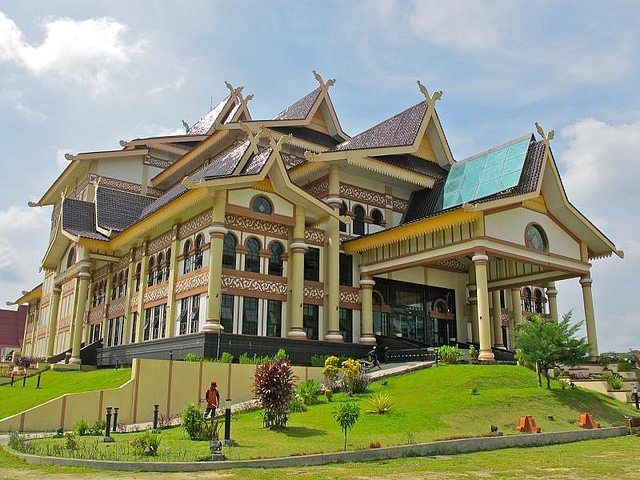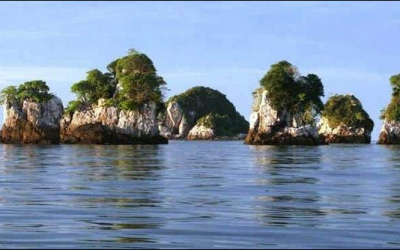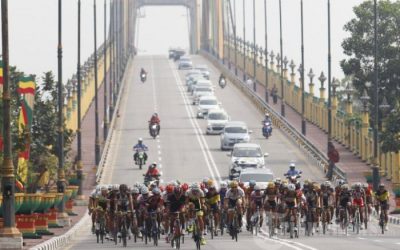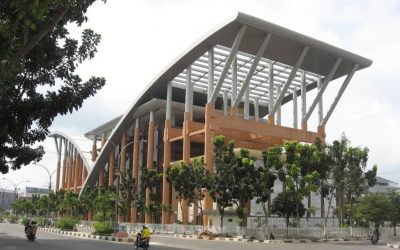Home / Batik Regions – Western Indonesia – Northern Sumatra – Riau / Idrus Tintin Cultural Center
Cultural Destination
Embrace the spirit of the place!
Idrus Tintin Cultural Center

The Idrus Tintin Cultural Centre (photo: Suryapost)
Idrus Tintin Cultural Center
Idrus Tintin Art Pavilion is an exhibition and cultural building in Pekanbaru. With a unique Riau-Malay style architecture, this building became the center of art and the Indonesian Film Festival (FFI) event in 2007. The name of the building was derived from a theater art innovator in Riau, Idrus Tintin.
Tourist Attractions in Riau
Jemur Island Riau
Jemur Island is a hidden paradise located in
Cycling race tour de siak
Tour De Siak is an annual international bicycle racing activity consisting of
Soeman HS Library
Pekanbaru is the capital of Riau Province and is also famous for educational
Riau
Batik Motifs
Kasih Tak Sampai
‘Kasih Tak Sampai’ is an idiom in the Indonesian language which refers to
Pucuk Rebung Riau
Pucuk Rebung symbolizes heart determination in achieving goals, good luck, and
Tabir Tanjung
Tanjung flower is a type of Cherry tree flower, which is commonly found in
Discover
Indonesian
Batik
Motifs
Tanah Liek
The word “Tanah Liek” refers to clay in Minang language. It is also known as
Tangerang Herang
Tangerang Herang motif is a symbol of Tangerang city. The Tangerang Herang batik motif consists of
Dayak Kamang
Kamang motif is generally found in the Dayak tribe shield because it is believed to
Gedhog Kembang Waluh
a combination of Javanese cultural motif of the Majapahit kingdom (XII-XIV century) with
Wirasat
Wirasat or divine inspiration is a gift from God. This inspiration is symbolized by
Karawo Pinang
Pinang refers to the Palm areca tree. This motif is considered as the original
Jupri Kembang Teh
Kembang Teh illustrates the tendrils of tea plants that grow in the highlands of
Bultiya
The word ‘Bultiya’ is an acronym of the three major tribes in North Kalimantan, namely
Kasih Tak Sampai
‘Kasih Tak Sampai’ is an idiom in the Indonesian language which refers to
Sero Tangga
The Sero Tangga illustrates an endearing feeling and sacrifices of a person to fulfil
Burung Bidadari
Bidadari birds are endemic birds in Halmahera. This motif represents an
Rangkiang
The word “Rangkiang” refers to the rice granary in the Minangkabau language. It symbolizes
Gorga Simeol-Meol
The Gorga Simeol-meol is a pattern of plant tendrils. it is regarded as a symbol of longevity and
Daun Lada Hitam
The black pepper motif represents the main commodity of Bangka Belitung
Prada Papua
The word “Prada” in the Javanese-Indonesian dialect means a batik textile that
Keluak Daun Pakis
The word “Keluak” is a Minang language which means twisted or tangled. The Motif of
Parang Seling
Parang Seling or “alternating daggers” is a royal batik motif. It is a feminine variant of
Desa Na Tolu
The Desa Na Tolu characteristic pattern symbolizes the Batak philosophy of existence and
Lipaq Sabe
Lipaq Saqbe contains a simple geometric classical motif with various flower decorations. This textile is
Sekar Jati
Sekar means flower and Jati refers to teak trees that symbolizes a strong mental character that
Ake Patra
Ake is related to the divinity and the composition of the universe. It is a symbol of
Tabir Tanjung
Tanjung flower is a type of Cherry tree flower, which is commonly found in
Pucuk Rebung Riau
Pucuk Rebung symbolizes heart determination in achieving goals, good luck, and
Parang Rusak
Another meaning behind this motif is an unconquerable spirit, symbolized by
Kain Cual
Cual textile tradition has existed since the 17th century. The word “Cual” refers to
Kawung
The Kawung motif was created by Sultan Agung Hanyokrokusumo (1593 – 1645) as a symbolic gift for
Taiganja
Taiganja is a precious gold pendant that shows the social status of the Kaili family. It is
Insang Ikan
Insang refers to the gills of the fish. This is a typical pattern of Malay ethnic who inhabits
Kuda Kupang
Horses symbolize wealth. It contains noble values of virtuous characters that bring
Dayak Taghol
Dayak Taghol has a distinctive style of four curved lines and small dots. This motif represents
Gonggong Beruntun
This motif illustrates that a person should maintain a positive attitude and
Paqbarre Allo
The word “Barre” means round and “Allo” means the sunlight. This motif is interpreted as
Ukir Sentani
The Ukir motif is a batik motif that is inspired by various traditional Sentani wood carvings
Pati-Pati Pinehiku
It symbolizes the hierarchy in society and the social status of the Mekongga
Bale Lumbu
This motif signifies the welfare of the ancient Sasak society. Bale also symbolizes the
Daun Simpor
This motif is inspired by the Simpor plant (Dillenia Suffruticosa) which is a typical
Manguni Minahasa
Manguni is identified as the symbol of the Minahasa people. Manguni is known as a
Sandeq
Sandeq Boat is a symbol of the maritime importance of the West Sulawesi region. The greatness of
Gigi Haruan Lidi
The Gigi Haruan Lidi motif is taken from the name of the cork fish and is a symbol of
Pinawetengan
The Pinawetengan Batik pattern was taken from a prehistoric inscription in
Pattimura
Pattimura is the name of an Indonesian hero who fought against colonialism in
Mahkota Siger
Siger is the crown of a noblewoman in ancient time. It is a symbol of femininity, strength, and
Wakatobi
It symbolizes the coastal beauty of the Wakatobi island and the symbol of Patra symbolizes
Awan Berarak
Awan Berarak is a combination of Dayak motifs and Malay patterns. The word ‘Awan Berarak’ means the
Lontara
The Lontara script itself is a typical ancient script of Bugis and Makassar communities. History records that
Kerawang Tegak Aceh
The Vertical Upright (Kerawang Tegak) Motif symbolizes a person who has a strong
Besurek Rafflesia
The term “Basurek” refers to a textile that contains letters or inscriptions
Tongkonan
Toraja’s traditional house is called Tongkonan. Tongkonan is a place for
Teguh Bersatu
This batik motif shows the strength of the people of Kupang. It also represents a sense of
Bomba Mawar
This motif means sacred love for family, kingdom, and God; It also illustrates
Tengkawang Ampiek
With its many advantages, the Dayaks use this leaf in ritual ceremonies. This plant is a symbol of
Cengkeh
The clove flower motif is the main commodity of the Tolitoli Regency. This motif represents
Malinau Cultural Festival
You will witness a unique competition that might not be found other than in
Daun Sirih
This motif illustrates betel leaves that are used by Lombok communities as traditional
Srimanganti
The name of the Srimanganti motif is derived from Palace’s hallway that connects to
Besurek Rembulan
This batik illustrates praise for God who created the wonderful universe
Kaganga Tanah Rejang
If Batik Besurek combines Arabic calligraphy motifs, then the Kaganga batik takes
Rumah Mamuju
the Batik motif illustrates the house of Mamuju King with the stairs, located on the left of the wooden stage house
Kaharingan
The Kaharingan or ‘tree of life’ based on the Dayak tribes’ belief system. This tree symbolizes
Gamolan
This motif illustrates Gamolan, a bamboo musical instrument of Lampung that is
Merak Ngeram
The hatching peacock motif has a very deep meaning which refers to the sacrifice and
Gentala Arasy
Built as high as 80 meters, the tower also highlights the historical side of
Pohon Hayat (Tree of Life)
The Batik motifs in Lampung are dominated by the acculturation of Buddhist and
Karawo Mahkuta
Mahkuta refers to Gorontalo’s traditional crown. It represents noble characters of
Gonggong Siput
Gonggong (Strombus Turturella) is one type of sea snail found around
Sido Mulyo
Sidomulyo is one of the classical motifs, which is specifically used for the bride’s costume in
Bekantan Pakis
This motif represents Pakis Haji (Polystichum setiferum), an endemic plant in
Tubo Kelapa
Coconut tree is a symbol of a good character and strong mentality. It illustrates the more success a person, the more
Salakanagara
Salakanagara batik motif illustrates the first kingdom in the Betawi land
Hiu Taliyasan
Indonesia is also home to the world’s largest fish, the whale shark (Rhincodon typus). Hiu Taliyasan refers to
Tenun Bima
The motifs are adopted from Bima woven textile. This pattern has received a great



